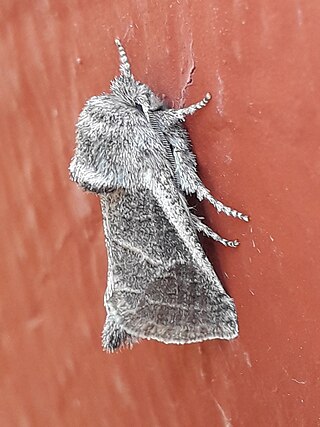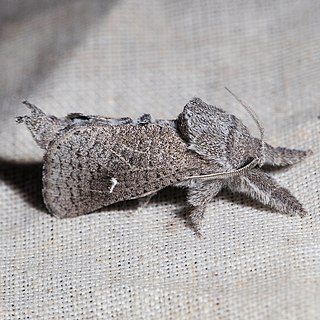
Lasionycta poca is a moth of the family Noctuidae first described by William Barnes and Foster Hendrickson Benjamin in 1923. It is found throughout the Rocky Mountains of Alberta, westward to the Coast Range in western British Columbia and southward in the Cascades to Okanogan County, Washington.
Fania connectus is a species of moth of the family Cossidae first described by William Barnes and James Halliday McDunnough in 1916. It is found in Texas in the United States.
Comadia is a genus of moths in the family Cossidae first described by William Barnes and James Halliday McDunnough in 1911.
Comadia bertholdi, the lupine borer moth, is a moth in the family Cossidae. It is found in the United States, where it has been recorded from Washington, Colorado, Wyoming, Arizona, California, Nevada and New Mexico.
Comadia dolli is a moth in the family Cossidae first described by William Barnes and Foster Hendrickson Benjamin in 1923. It is found in North America, where it has been recorded from Arizona, California, Nevada and New Mexico.
Comadia henrici is a moth in the family Cossidae. It is found in North America, where it has been recorded from California, Arizona, New Mexico, Colorado, Nevada and Utah.
Comadia manfredi is a moth in the family Cossidae. It is found in North America, where it has been recorded from Arizona and New Mexico, as well as Ohio.

Comadia redtenbacheri is a moth in the family Cossidae. It is found in North America, where it has been recorded in Mexico and southern Texas.
Comadia suaedivora is a moth in the family Cossidae. It is found in North America, where it has been recorded from California.
Comadia subterminata is a moth in the family Cossidae first described by William Barnes and Foster Hendrickson Benjamin in 1923. It is found in North America, where it has been recorded from Arizona, Utah, Colorado and New Mexico.
Comadia alleni is a moth in the family Cossidae. It is found in North America, where it has been recorded from California.
Comadia arenae is a moth in the family Cossidae. It is found in North America, where it has been recorded from California.
Comadia speratus is a moth in the family Cossidae. It is found in North America, where it has been recorded from California.
Comadia albistrigata is a moth in the family Cossidae first described by William Barnes and James Halliday McDunnough in 1918. It is found in North America, where it has been recorded from Arizona, New Mexico and Texas.

Hypopta palmata is a moth in the family Cossidae first described by William Barnes and James Halliday McDunnough in 1910. It is found in North America, where it has been recorded from western Texas, Arizona, Nevada, California and Baja California Norte. The habitat consists of deserts and desert mountains.
Givira cleopatra is a moth in the family Cossidae first described by William Barnes and James Halliday McDunnough in 1912. It is found in North America, where it has been recorded from Arizona, California, Nevada and Utah.

Givira lotta, the pine carpenterworm moth, is a moth in the family Cossidae. The species was first described by William Barnes and James Halliday McDunnough in 1910. It is found in the United States, where it has been recorded from California, Arizona, New Mexico and Colorado. The habitat consists of pine forests.

Givira marga is a moth in the family Cossidae first described by William Barnes and James Halliday McDunnough in 1910. It is found in North America, where it has been recorded from California and Arizona.

Givira minuta is a moth in the family Cossidae first described by William Barnes and James Halliday McDunnough in 1910. It is found in North America, where it has been recorded from southern Arizona.

Givira lucretia is a moth in the family Cossidae first described by William Barnes and James Halliday McDunnough in 1913. It is found in North America, where it has been recorded from Arizona, Texas and Wyoming.





